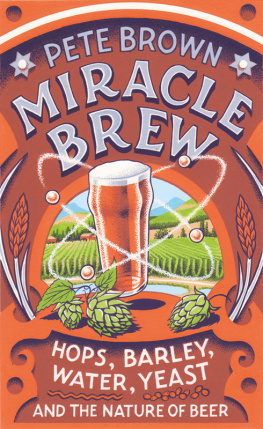CHAPTER 1
NATURAL INGESTION OF ETHANOL BY ANIMALS: WHY?
W.C. McGrew
Introduction
W hy would any organism habitually ingest a toxic substance? If toxins decrease net fitness in terms of lifetime reproductive success, then natural selection should favour individuals that avoid consuming them, versus those that do. Ethanol is such a toxin, e.g. it directly kills nerve cells. Yet, it is naturally consumed by a variety of animal taxa, both invertebrate and vertebrate: Diptera, especially Drosophila spp.; Hymenoptera; Lepidoptera; among birds, Passeriformes, e.g. waxwings, Bombycilla spp.; among mammals, Bovidae, Proboscidae, Suidae (for review of references, see Dudley 2000; Eriksson and Nummi 1982). So, do the benefits outweigh the costs?
Ethanol is produced by fermentation of sugars by yeast (microscopic fungi). In nature, this most commonly involves the simple sugars found in ripe fruit, and so ingestion is associated with facultative or obligate frugivory. Toxicity is said to be an evolved strategy of micro-organisms that allows them to triumph over macro-organisms in competition for these calorific resources (Janzen 1977). Thus, there is an evolutionary arms race between yeasts and other fruit-eaters, whether these be other microbes or large-bodied vertebrates. The counter strategy of ethanol consumers is physiological, and is basically the same from butterfly to barfly. Ethanol is metabolised (detoxified) by a two-stage, enzymatic process: alcohol dehydrogenase (ADH) breaks down ethanol into acetaldehyde, then aldehyde dehydrogenase (ALDH) breaks that down into acetate, and acetate is then incorporated into the Krebs cycle.
The yeasts strategy is not decisive, however, as ethanol ingestion is commonplace. In fruit flies (Drosophila spp.), all stages of the life cycle consume ethanol and the larvae develop in an alcoholic culture of rotting fruit pulp. Both in humans and nonhumans, ethanol ingestion goes beyond direct consumption of fruit to the liquid form, wine, garnered from monosaccharides in fruit, nectar, sap, honey, etc. For example, seven species of mammals, including three species of primates (pentailed treeshrew, Pitlocercus lowii; common treeshrew, Tupaia glis; slow loris, Nycticebus coucang) regularly consume the fermented nectar of the bertam palm, Eugeissona tristis (Wiens et al. 2008).
However, humans apply simple technology such as heat to complex carbohydrates, such as starch, to break down polysaccharides into simple sugars for fermentation, thus producing beer from cereals or tubers. Finally, humans apply even more impressive technology (distillation) to transform low-concentration alcoholic fluids to high-concentration ones (spirits). Production of ethanol for ingestion seems to be a human universal, found in all societies with access to apt raw materials (Brown, 1991).
Finally, one must explain not only the physiological aspects of ethanol ingestion, but also its behavioural and cognitive aspects. Ethanol-consuming organisms of all types sometimes ingest it to the point of intoxication (as measured by altered motor patterns) and show high appetitive motivation (as measured by response to deprivation or willingness to work for ethanol as a reward) (Fitzgerald 1972).
Hypotheses
Seven hypotheses seem to explain ethanol ingestion. These need not be mutually exclusive, but each can be tested individually, at least in principle. These are presented below in order of increasing complexity:
- accident, ingestion may be an inadvertent by-product of frugivory
- pathology, ingestion may be anomalous by nature or nurture, in individuals that knowingly or otherwise seek self-injury
- nutrition, ingestion may be energy-seeking
- medicine, ingestion may be health-enhancing
- gustation, ingestion may be taste-rewarding
- hedonism, ingestion may be psychologically disinhibiting, leading to enhanced pleasure or to relief of pain
- cognition, ingestion may alter intellectual capacity, leading to risk-taking or altered states of consciousness
Below, each of these hypotheses will be examined in terms of what is known in the published literature on ethanol ingestion by nonhuman species.
Results
Accidental ingestion seems likely for ingestion of pulpy, succulent fruits that gradually ripen, especially since ethanol is always present in ripe fruits (Dudley 2002). Fruits need not be rotten or overripe before fermentation starts; rather, it is only a matter of sufficient sugar content plus yeast spores, and the latter are ubiquitous. However, ethanol levels in ripe fruit are low, typically of the order of 0.1 per cent, so that their consumption is unlikely to have physiological or behavioural effects on fitness. Higher ethanol levels in rotting fruit are signalled by distinctive odour, taste, and even appearance, with the former often being detectable at a distance before the fruit is handled. This makes accidental ingestion of significant levels of ethanol unlikely.
More conclusive evidence of non-accidental ingestion comes from goal-directed selection of fermented fruit over non-fermented fruit. This is well-known in Drosophila life-history, e.g., egg-laying, but there seem to be no data for vertebrates, except as natural history anecdotes (e.g., Siegel 1989). In unnatural conditions in captivity, preference for ethanol can be developmentally induced in a wide range of vertebrates, but the procedures typically require extreme experimental manipulation (Siegel and Brodie 1984). Again, this suggests that habitual ingestion in nature is accidental.
Finally, when whole clades of insects normally ingest ethanol, it seems unlikely to be happenstance. The same applies to certain passerines, especially long-distance, migratory frugivores, but the situation for mammals remains unclear.
Pathological ingestion of ethanol may explain individual cases by analogy to alcoholism in humans. This explanation is strengthened by studies reporting successful experimental induction of ethanol addiction in nonhumans (e.g. Kornet et al. 1990) and naturalistic accounts (Marais 1969: 98101, on wild baboons). Furthermore, genetically based variation in ADH and ALDH isozymes across human populations have been implicated in cross-cultural differences in alcohol abuse (see review in Dudley 2002).
However, for the reasons given above, pathology cannot account for obligate ingestion of ethanol in invertebrates and (apparently) birds. Again, the situation for mammals in natural circumstances remains unclear, as anecdotes (that is, accounts of rare or even unique events) may indicate only idiosyncrasy (that is, persistent individual patterns of behaviour, e.g., Carrington, 1959: 68) and may not generalise to widespread habits (Siegel 1989). Even if systematic, comprehensive data showed mammals to be regular consumers of ethanol, and even if short-term studies revealed no ill-effects, longer-term data are needed to test the hypothesis of lifespan pathology.
Nutritional ingestion of ethanol seems straight-forward: it is a better source of calories than unfermented carbohydrates, in terms of direct kcal/g yield. Furthermore, the odour plumes of ethanol may attract frugivores to indirect benefits of available calories from sugars present in patches of both ripe and overripe fruit (Dudley 2000).
However, a diet in which a high proportion of calories come from ethanol (and human alcoholism is sometimes defined accordingly) is malnutritional. Such empty calories may be deficient in other nutrients, although this varies from spirits to wine to beer, with the latter sometimes being labelled as











